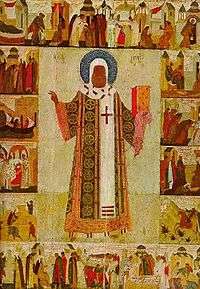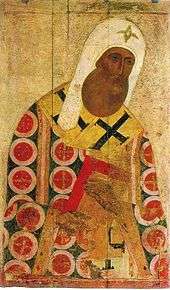Saint Peter of Moscow
Saint Peter, Metropolitan of Moscow and all Russia (Russian: Пётр; died on 20 December 1326) was the Russian metropolitan who moved his see from Vladimir to Moscow in 1325. Later he was proclaimed a patron saint of Moscow. In spite of the move, the office remained officially entitled "Metropolitan of Kiev and All Rus'" until the autocephalous election of St. Jonah in 1448.
Life
Peter was born in Galicia–Volhynia. His parents were Theodore and Eupraxia. At the age of twelve, young Peter entered a monastery where he learned iconography. The igumen of the monastery had St Peter ordained as a hieromonk. After years of ascetic labors at the monastery, the hieromonk Peter, with the blessing of the igumen, left the monastery in search of a solitary place. [1]
He built a cell at the Rata River and began to pursue asceticism in silence. Afterwards, at the place of his ascetic exploits, a monastery was formed, called the Novodvorsk. The Icon of the Most Holy Theotokos “Of St Peter” was so called because it was painted by St Peter, Metropolitan of Moscow while he was igumen of the Ratsk monastery near Volhynia. During a visit to the Ratne[2] monastery by St Maximus, Metropolitan of Kiev and All Rus', Peter gave him the icon as a gift.[3]
In 1308 king Boleslaw-Yuri II of Galicia nominated and the Patriarch of Constantinople appointed Peter to the vacant see of Kiev and all Rus'.[1] Mikhail Yaroslavich, Grand Prince of Vladimir and Tver, wanted to advance his own candidate for this position. Peter's nomination caused prolonged animosity between Mikhail and Peter to the point that the latter had to ask for protection from the Prince of Moscow in 1325.
Peter travelled to Constantinople where Patriarch Athanasius consecrated him as Metropolitan of Russia and bestowed on him the hierarchal vestments, staff and icon. Upon his return to Rus' in 1308, Metropolitan Peter arrived at Kiev after a year, and then proceeded on to Vladimir. During this time of Tatar (Mongol) authority Russia was in turmoil, and Peter was often obliged to change the place of his residence.[1]
Peter transferred his metropolitan duties from depopulated Kiev to Vladimir. In 1325 Metropolitan Peter, at the request of Great prince Ivan Kalita (1328-1340), transferred the metropolitan cathedra-chair from Vladimir to Moscow.[4] The move strengthened the political position of Moscow and established it as the spiritual capital of fragmented Russia. After Peter's move to Moscow, the Cathedral of the Dormition and several other stone churches were built by Ivan Kalita in the Moscow Kremlin. The foundation of the Vysokopetrovsky Monastery in Moscow is ascribed to Peter. He also authored a few sermons and epistles.
Peter died on 21 December 1326.[4] After his canonization by Metropolitan Alexis, his veneration was propagated all over Moscovy. Accordingly, many churches were dedicated to Peter the Metropolitan in Moscow and other cities of Russia. His feast day is celebrated on 24 August (the translation of his relics to the Dormition Cathedral in Moscow) and 5 October (in common with Metropolitans Jonah and Alexis)
References
- 1 2 3 "Repose of St Peter the Metropolitan of Moscow and Wonderworker of All Russia", Orthodox Church in America
- ↑ Ratne, Volyn Oblast in the The History of Cities and Villages of the Ukrainian SSR
- ↑ "Icon of the Mother of God of St Peter of Moscow", Orthodox Church in America
- 1 2 Janos, S., "Sainted Peter, Metropolitan of Moscow", Holy Trinity Orthodox Church
External links
- (in English) Petro of Kyiv, Metropolitan in the Encyclopedia of Ukraine
- Translation of the relics of St Peter the Metropolitan of Moscow and All Russia Orthodox icon and synaxarion
- Synaxis of Peter, Alexis and Jonah, Metropolitans and Wonderworkers of All Russia
| Eastern Orthodox Church titles | ||
|---|---|---|
| Preceded by Maximus |
Metropolitan of Kiev in Moscow | Succeeded by Theognostus |

